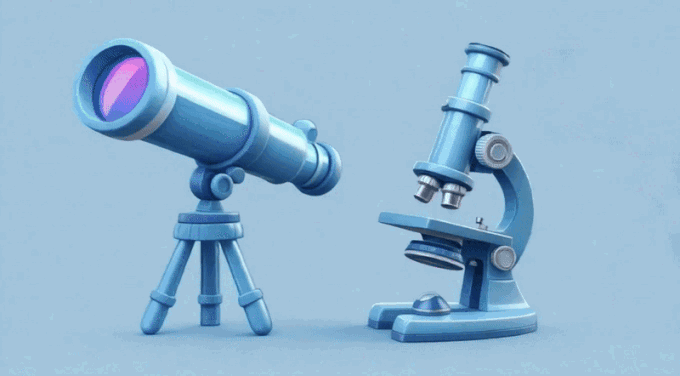Summary: Human vision has always been limited, but through centuries of innovation—from early lenses to today’s most advanced microscopes and telescopes—we’ve extended our sight to both the atomic level and to distant galaxies. Instruments like cryo-electron microscopes and space telescopes have amplified our ability to explore the microscopic and cosmic, transformed our capacity for discovery.
Limitations in our sense of vision have driven us to invent and share new instruments of knowledge discovery. The unaided human eye can see a 100 micrometer (μm) object, about half the diameter of a human hair. Naked-eye stargazers can see a sufficiently bright celestial object up to 2.5 million light-years away. This was the extent of our vision until around 1600, when glassmakers in the Netherlands started to experiment with shaping lenses. The results of their experiments have given us the astonishing power to see millions and even billions of times more.
Microscopes
Zacharias Janssen developed the first microscope in 1595. It could magnify objects 3 to 10 times their size. By the 1800s, magnification had improved to 1,000 times. A significant advancement occurred in 1931 with the use of the transmission electron microscope (TEM), which could magnify up to 1 million times. TEMs range in cost from $100,000 to $10 million or more, depending on their features. The most advanced TEM, located at Lawrence Berkeley National Laboratory, costs $27 million. This microscope can achieve a resolution of half the width of a hydrogen atom, making it the most powerful microscope in existence.
The scanning electron microscope (SEM), developed in 1937, had lower magnification (approximately 100,000 times) but could produce three-dimensional images. From the 1980s to the present, cryo-electron microscopy (cryo-EM) has increased magnification up to 5 million times; scanning probe microscopes—using methods such as atomic force microscopy (AFM) and scanning tunneling microscopy (STM)—have increased magnification up to about 100 million times.
However, magnification is only marginally meaningful unless paired with resolution, since empty magnification yields no useful details. For true improvement, resolution is critical.
The light microscopes of the 1800s could see 500 times more, at 0.2 μm. In the 1930s, electron microscopes improved resolution to 0.05 nanometers (nm), an increase to 2 million times magnification. Today’s cryo-EM/atomic microscopes have a resolution of 0.001 nm, which is 100 million times that of the unaided human eye.
Telescopes
Hans Lippershey is credited as the inventor of the first telescope, created in 1608. His instrument could magnify 3 times. After learning of the innovation the following year, Galileo built his own version and increased magnification to 30 times, yielding a 10 times improvement in one year. Telescopes have continued to improve in light-gathering power and resolution. In the 1700s and 1800s, innovations by Isaac Newton and others improved both of these factors. The Herschel reflecting telescope, produced in 1789, had 20 times better resolution and over 1,000 times better light-gathering power than the Galileo design. The Great Dorpat Refractor, built by Joseph Fraunhofer and completed in 1824, was the first modern, achromatic, refracting telescope. While the Herschel had a larger aperture, the Dorpat had much higher-quality lenses, yielding sharper and more measurable images.
The Hooker telescope was built in 1917 and offered 3 times resolution and 105 times improvement in light-gathering power over the Dorpat. The next major advancement was the creation of the Hubble telescope in 1990. As a space-based telescope 340 miles above the Earth’s atmosphere, it was 10 times sharper and more stable than its Earth-based counterparts. The James Webb Space Telescope (JWST), launched in 2021, has a much larger mirror (6.5 meter vs. 2.4 meter), giving it vastly greater light-gathering power, and it is optimized for the infrared spectrum.
The Extremely Large Telescope (ELT) is scheduled to go online in 2030. Compared to the JWST, the ELT is 6 times larger, giving it dramatically higher light-gathering power for ground-based observations. The ELT will achieve 14 times sharper resolution (0.005 arcsec vs. JWST’s 0.07 arcsec), especially when using adaptive optics. The JWST retains the edge in overall precision due to its space-based stability and optimized infrared systems, but the ELT will surpass it in spectroscopy, exoplanet imaging, and capturing the detailed structures of distant galaxies.
From the unaided human eye to the ELT, angular resolution will be 12,000 times better and light-gathering power will be 31 million times better. This gives the ELT a combined observational capability approximately 372.5 billion times greater than the unaided human eye. This staggering difference reflects advances in both resolution and light-gathering power, enabling us to study the universe in ways that were unimaginable just a few centuries ago.
Microscopes and telescopes are instruments of knowledge discovery. There has never been a better time to be alive if you want to zoom in and look at an individual 0.05 nm atom or zoom out and look at the edge of the universe, some 46.5 billion light-years away from Earth.

